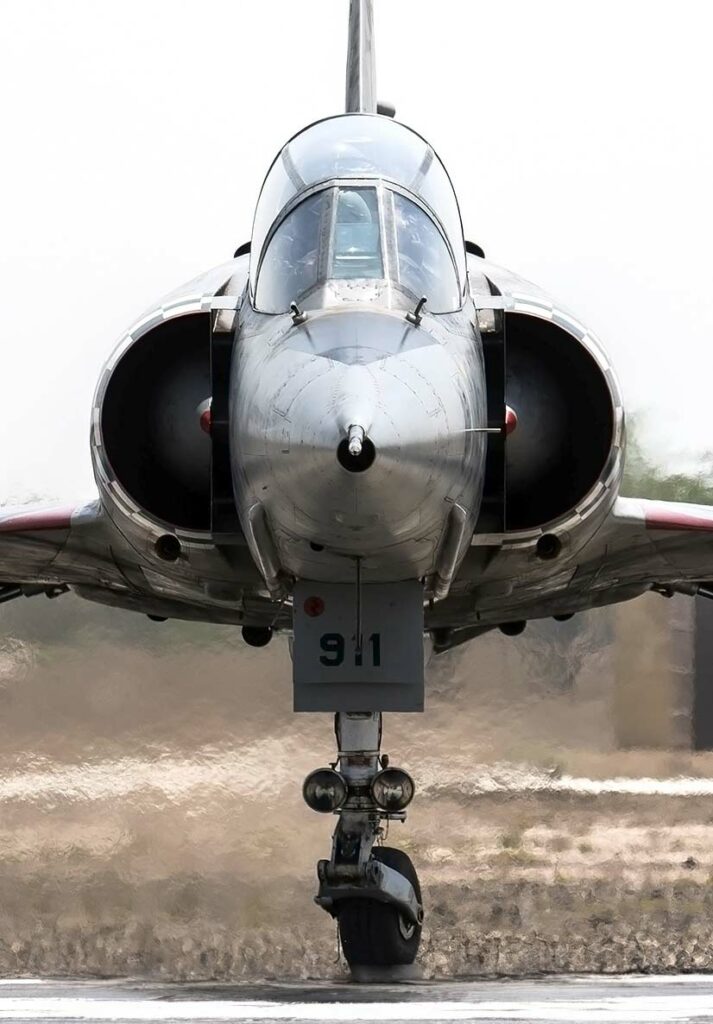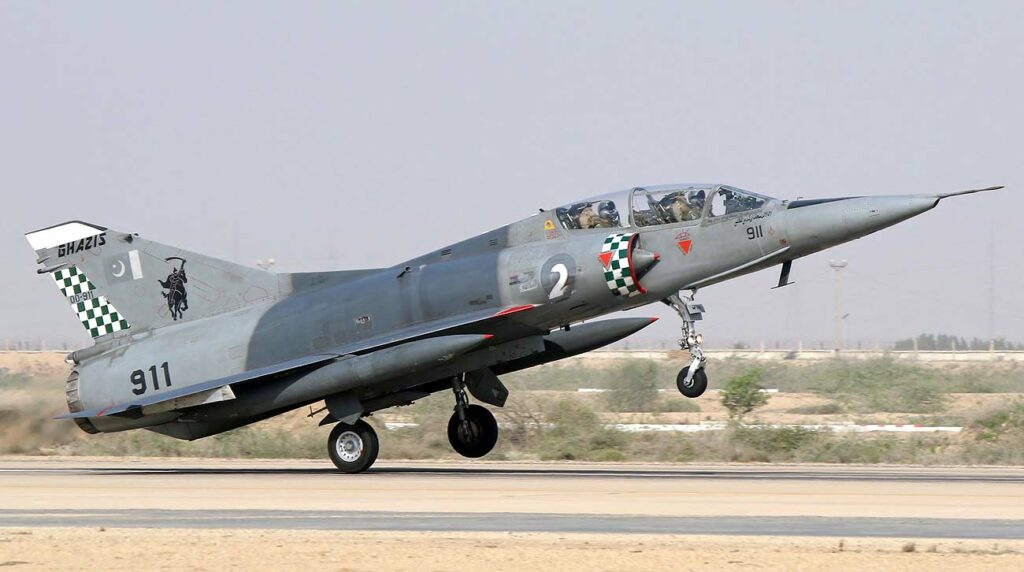The Dassault Mirage V is a single-engine, supersonic jet designed for ground-attack, recognized for its delta-wing design and high-performance capabilities.
In brief
The Dassault Mirage V, a derivative of the Mirage III, is optimized for ground-attack roles, embodying a streamlined design with a delta-wing configuration, enabling high-speed flight and agility. Introduced in the 1960s, it’s equipped with a powerful Atar 9C turbojet engine, facilitating supersonic speeds and efficient low-altitude flight. The aircraft is armed with cannons and an array of munitions, including guided missiles and bombs, tailored for precision strike missions. With advanced avionics for its time, it combines robust performance in both air-to-surface and secondary air-to-air combat roles, serving various air forces worldwide with distinction.

History of the Development of the Dassault Mirage V
The development of the Dassault Mirage V was primarily driven by a specific request from the Israeli Air Force in the early 1960s, which sought a simplified Mirage III variant optimized for ground-attack missions. This variant was intended to be more cost-effective, focusing on strike capabilities rather than the all-weather interceptor role of its predecessor. The design changes resulted in an aircraft with reduced avionics, no radar, and an increased internal fuel capacity to enhance its range and loitering time over the battlefield.
Dassault Aviation launched the program, adapting the successful Mirage III platform to meet these specifications. The Mirage V first flew on 19 May 1967, showcasing its capabilities that aligned with the tactical requirements of close air support, interdiction, and reconnaissance missions. Despite its origins linked to an Israeli requirement, geopolitical pressures led to an embargo, redirecting the initial production batch to other countries, with France eventually adopting a modified version, the Mirage 5F.
Design of the Dassault Mirage V
The Mirage V maintained the delta-wing design characteristic of the Mirage family, favoring high-speed performance and agility. It featured a lighter avionics suite and omitted the radar, which, coupled with additional fuel tanks, significantly extended its range. The aircraft was designed to operate efficiently at low and medium altitudes, ideal for its ground-attack role, with enhancements allowing for a greater payload capacity and improved low-altitude flight stability.
Powered by the reliable SNECMA Atar 9C turbojet engine, the Mirage V could achieve speeds of Mach 2.2, with modifications from its predecessor reducing its takeoff distance and improving its overall maneuverability. It was equipped with two 30 mm DEFA cannons and had nine hardpoints for carrying a range of ordnance, including conventional bombs, cluster munitions, and air-to-surface missiles, making it a formidable platform for tactical strike missions.
Performance of the Dassault Mirage V
The Mirage V’s performance profile was centered around high-speed, low-altitude strike missions. Its Atar 9C engine, providing a thrust of 13,500 lbs, allowed for a top speed of over Mach 2 and a service ceiling exceeding 50,000 feet, though it typically operated at much lower altitudes for ground-attack missions. The aircraft had a combat radius of approximately 250 miles, which could be extended with external fuel tanks.
While not equipped for extensive air-to-air combat, the Mirage V could defend itself against enemy aircraft with its cannons and, in some variants, air-to-air missiles. Its agility, speed, and low-altitude performance made it a challenging target for enemy air defenses, and it could deliver a variety of munitions with precision, thanks to its advanced navigation and targeting systems.
Variants of the Dassault Mirage V
The Mirage V spawned several variants to suit different operational requirements:
- Mirage 5: The baseline version, focusing on ground-attack.
- Mirage 5F: France’s adaptation with improved avionics and the capability to carry French-specific weapons.
- Mirage 50: An upgraded variant with a more powerful engine and modern avionics, including a radar for enhanced all-weather capability.
Export versions were customized to meet the specific needs of different countries, leading to numerous sub-variants with diverse avionics, armaments, and capabilities.

Military Use and Combat of the Dassault Mirage V
The Mirage V saw extensive military use, particularly in the Middle East and Africa, where it was involved in various conflicts. Its combat debut was with the Israeli Air Force, albeit in the form of the Mirage III, which heavily influenced the Mirage V design. The aircraft was later used by several air forces in conflicts such as the Yom Kippur War, where it conducted deep-penetration strike missions, showcasing its effectiveness in suppressing enemy air defenses and hitting strategic targets.
In South America and Asia, the Mirage V served in both peacetime and combat roles, demonstrating versatility across different operational theaters. Countries like Pakistan utilized the Mirage V extensively, particularly in border skirmishes and during periods of tension with neighboring India, where it performed reconnaissance, patrol, and precision strike missions. The aircraft’s reliability and robust performance in challenging conditions made it a valuable asset in prolonged operations, including the Kargil Conflict, where Pakistani Mirage Vs were reported to have conducted successful ground-attack missions.
The Mirage V’s adaptability was further showcased in the Falklands War, albeit indirectly, as Argentina employed the Mirage III, the predecessor and close relative of the Mirage V, in air sovereignty and interception roles. Though the Mirage V itself was not involved, the operational use of its predecessor underlines the aircraft’s potential effectiveness in similar conflict scenarios.
Exported widely, the Mirage V served in various air forces around the globe, from Egypt and Libya in North Africa to Peru and Venezuela in South America. Its use in these diverse regions attests to its adaptability to different climates and operational requirements, from desert operations in the Middle East and North Africa to the more temperate environments in Europe.
Despite its success, the Mirage V gradually faced obsolescence due to advances in aviation technology, leading to replacement or upgrades in most operating countries. Some air forces opted to enhance their existing Mirage V fleets with modern avionics, improved engines, and new weapon systems, extending the aircraft’s service life and operational relevance into the 21st century.
To recap
The Dassault Mirage V epitomizes the evolution of jet-powered combat aircraft, specifically tailored for effective ground-attack and reconnaissance missions while maintaining considerable air-to-air combat capabilities. Its development was a testament to Dassault’s commitment to innovation, responding adeptly to the shifting dynamics of military aviation and the specific needs of its operators. With a design philosophy emphasizing simplicity, robustness, and performance, the Mirage V carved out a niche for itself as a versatile and reliable aircraft that could deliver precision strikes, gather crucial intelligence, and assert air dominance.
Throughout its operational history, the Mirage V demonstrated not just the prowess of French aviation technology but also the importance of adaptability in military assets, being able to undertake a wide array of missions in various conflict scenarios worldwide. As nations transition to more modern aircraft, the legacy of the Mirage V continues, embodied in the lessons learned from its extensive service record and its contributions to the effectiveness and tactical flexibility of air forces around the globe. The aircraft’s enduring legacy is marked by its impact on the development of future multirole combat platforms, which continue to draw on the design excellence and operational versatility that the Mirage V so effectively exemplified.
Back to the Fighter Jet section.